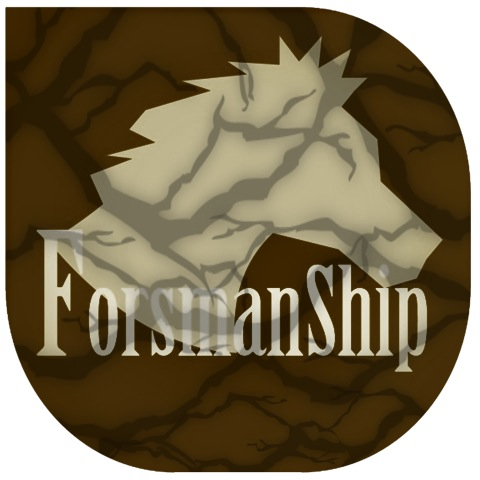
Horseman Forsman News
Articles about animals and the people who love them ...
The Recipe For Forsmanship
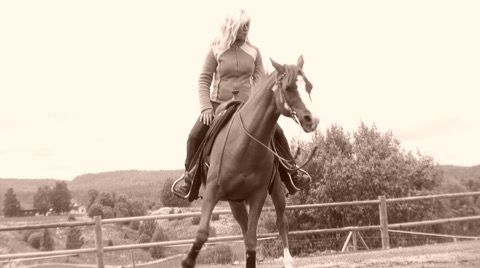
Bjørg Andreassen and Zantos demonstrate at a Forsmanship clinic in 2011
It is testament to the sustainable results of Stefan Forsman’s work that even students from two decades ago - dedicate part of their Scandinavian summer vacation - and gather at a ranch in Norway to catch up and learn more.
We are talking to Bjørg Andreassen Hals - the warm, grounded and talented Norwegian horse riding champion - who is hosting a special five day advanced Forsmanship clinic at her Holen Ranch, outside of Oslo.
Bjørg is absolute when she talks about her trust and respect for Stefan. Her value in competition with her beloved Arab - Zantos - soared after she became a student of the Forsmanship training methodology in 1997.
There is something very important that people learn when they journey through an education with Stefan, Bjørg says, and it is also what makes these horse owners and riders true horse lovers. It is in their willingness to put their horses first, Bjørg claims, because they have questioned their own skills and existing knowledge and approach to handling animals. This attitude to learning, or rather, learning to unlearn old ways and relearn, she says, lies at the heart of Forsmanship and its success.“Stefan is one of the biggest horse men in the world and I cannot thank him enough for what he has taught me,” says Bjørg, interviewed during preparations for the week long Forsmanship intensive. Older students are returning for one simple reason, she says. “They are coming back because they still know that Stefan has more to give.”
Unfortunately, however, there are still a lot of horse owners who want a “quick fix” and don’t bother, explains Bjørg. Yet, they want the same results.”You have to do the work yourself to get there,” says Bjørg.
It is a strange paradox in the horse industry that sadly continues. That is, says Bjørg, it is sad that many horses do suffer from old styles of training and often with riders who don’t really know what they are doing to their animals. Probably the worst kind are horse owners who just want to enter competitions and win - and do so with very little regard for the horses they are riding, says Björg.
They see what people like Stefan achieve and especially horses with problems, she says, but they are not prepared to put in the work themselves. In fact, they miss the point, entirely.“They are the wanna haves. I want someone else to fix the problems with my horse, so I can win at competition,” she says.
“These kinds of owners will come along and want you to fix their horse so they can ride them and before you know it, the horse has problems again. I have experienced this myself and now understand what Stefan has had to go through. They want me to fix their horse but they don’t understand they have to do it themselves. You need to be much more than a rider. You need to know more about horses and you need to know how to work with horses correctly.”
In Scandinavia, says Björg, it is known as doing *the dirty work* and is most common in competition circles in dressage and jumping, where owners and riders who have the money employ grooms and stable workers - who put in the work, so to speak. But there is a huge gap in this kind of approach and it is not sustainable, she says. It is not in the best interests of the horse, especially when old methods are being used that not very humane. And owners who hold onto these old ways and attitudes are clearly not growing much either.
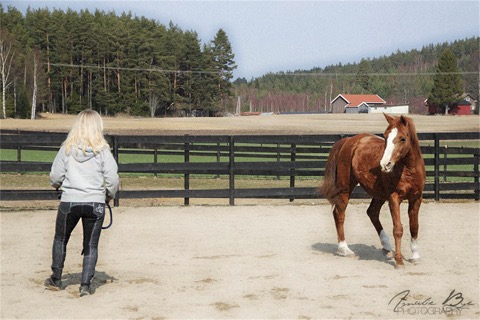
Björg demonstrating at a Forsmanship foundation course in March, 2014. Photo by Amelie Bye
Bjørg always refers to two periods of her life with horses - Before Stefan and After Stefan.
She says that she first found out about Stefan in Arabian Horse Magazine. Her horse Zantos, she claims, was a totally different horse back then.“A lot of negative things had happened to him, he would try to scratch me off against trees, he attacked me, he chased my daughter out of the paddock and tried to run me out too. “So, joining this course with Stefan was the best thing that could happen. He had me at the theory (which happens in the first three days of a foundation course). I felt like a big sponge. I soaked up as much as I could. He gave me a recipe from A to Z. I was so impressed. And I was so interested. He presented it in a way that was perfect for me. I started to see that my horse was unhappy.”
As Bjørg progressed with the work, she says that her own self-realisation of how she had approached Zantos before, really started to kick in.“What I learnt, was it was all about me, and how you need a certain attitude change to make things happen. You have to think about yourself and what energy you are giving off. I learnt that I was too tough and that was what I had to go through. Can you believe it? I was once a whips and spurs rider? Back then, I thought I wasn’t tough enough.”
“I had so many problems, which I thought were normal.”
“After that first three days, I left with answers for questions that I didn’t even know that I had. Stefan gave me the best recipe ever. People who knew Zantos before, thought that I had bought a new horse. The woman I had bought him from, asked me: what have you done, what is the recipe? Well, the main change was *me* I would tell people. New knowledge. New attitude. In the week following those 3 days of theory, I began to work Zantos in the round paddock. From the ground, I worked on getting his trust back.”
“I decided to leave jumping and dressage altogether and I found western riding. It felt more natural for me. I started riding long rein and it became my goal to ride Zantos without a headstall and we went on to become the most winning team in Norway, three years in a row. We got the big trophy.
”Before Stefan, I could never imagine that could happen. But I had to do so much training to undo what I had done earlier.”
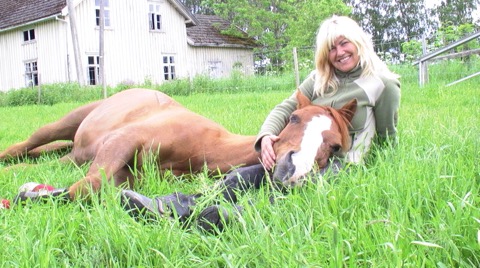
Bjørg’s determination to help Zantos turn around culminated also at a major horse show in Oslo, a very big yearly event in Norway, where different horse breeds and styles are exhibited.
And lay down, Zantos did, inside this big arena, in front of thousands of people from different countries.“I was there for the Arab segment and to show their versatility and a friend convinced me to lay him down, which is something I had never done publicly before,” says Bjørg.
”There was Zantos sitting like a dog and people were crying ... Overnight, I was suddenly turned into this horse whisperer with the magic hand. So many owners came to me after seeing me in that arena.” says Bjørg.
Meeting Stefan Again ..
It was not for another two years, after doing her first three days of Forsmanship theory, that Bjørg and Stefan would meet again.This was because Stefan had retreated for a while, says Bjørg because of a very unjust campaign to smear his methods and name, which was already underway when she first became a student. Naturally, Stefan was very affected by this campaign against him. It was bad, says Bjørg.
Stefan was being unfairly targeted for what was, truly amazing work - which was progressing the lives for all animals.
Thankfully, Stefan did re-emerge and old and new students have since proudly stood by him and his work - and continue to validate the effectiveness of the Forsmanship methodology.For Stefan, it is wonderful to see this backbone of people come forward. When students take his methods and put their heart into them to produce wonderful results, this gives Stefan much heart and faith to persevere as a teacher.
Björg says she remembers the day when she finally got to show Stefan what she had done with Zantos. It was at the time that he was still being impacted by harsh and unfounded criticisms
Basically, it was a situation that showed how faith can be restored when proof wins out in the end.“He was like a grumpy old guy. But when he saw what I had done with Zantos, I shall never forget the look on his face. He said that I was one of the 1 in 3000 who had done their homework. It totally changed him, I could see that he was so proud of our achievement ... and we started to put Zantos into clinics to show new students.”
As Björg implies, it was clearly obvious to those - like her - who had actually studied and practiced Forsmanship that those critics making noise had either not pursued the methodology properly - if at all - and didn’t have a clue. Otherwise, they would have some idea about what they were missing out on.
Because of this resistant attitude, Bjørg says that she too - like Stefan - has learnt to become more cautious. Especially with people who approach her with problem horses but don’t care enough to learn more about the methodology.
Bjørg however, said she liked a challenge, so after carefully explaining that it would become important that the owner also engage with the challenge, she decided to start working with the jumper and brought along a rope and halter to see what he was like. She began communication with him in his stall, while he was eating. Her plan, she said, was to start by trying to back him up.“I am not like Stefan, I cannot take just any horse with lots of problems. And he has told me many stories about why I should avoid these kinds of people who don’t take the time to do it properly. Though I did agree to it once, which taught me a lesson. I was approached by a showjumper who wanted me to work with his horse. A jumper who was very aggressive... and when he pulled his ears back, he didn’t look too friendly. He was a nightmare, really. He had been badly raised. Nobody could catch him in the paddock, he would lower his head and run you out. They even had to change riders inside the stable, or else he would try to eat you or kick you. On top of that, he was hard to saddle, to change a rug on, to brush or to clean his hooves. They even had to lead him with a muzzle to keep themselves safe.”
Bjørg also remembers the day when she led him into the forest and decided to ride him home.“But he got rougher and rougher and I was at the end of my limits. Although, that day, he did move his hind legs 2 inches. So that was a start. I then began walking him about 1.5 kilometres down the road and I had the guts to say get out of my way when he came too close”
Bjørg had started to make some progress. However, the day that she wanted to move the horse to round pen work, the owner decided that his horse had been “already fixed” and despite Bjørg spending hours explaining that the program was only just beginning, she never got a call again.“As we came in, people at the stables started turning the other way. They considered this jumper to be the most dangerous horse in Norway ... Another day when I was training him to get in and out of a horse box, the farrier came out and he ran and hid behind a car.
A year later, says Bjørg, she learnt that the showjumper, during this period, had tried to sell the horse onto the American market at a high price, claiming that he could jump houses.“This guy was so ungrateful and I didn’t get paid either.”
The father though kindly helped Bjørg recover the money that was owed to her but the experience, she says, is why she now holds back from helping people who want to bring their horses to her to be fixed. ””But he failed to let potential buyers know that his horse still had problems and was potentially dangerous,” says Bjørg. And they found out, so after all that, he was forced to sell him at a cheap price to a nephew - and it was the father of this young nephew who met a friend of mine who told him about the way I had been treated. He was aware of the progress that I had made with this jumper and made the comment that I had magical fingers. Of course, I said: No, I just learnt to understand him.”
I now hold back because even with everything explained, these people still didn’t let me finish.”
“I can spend hours talking with people, to see if they are still in and they do something like this. I can’t understand that. Why? If they don’t want to follow the recipe ... I think they are stupid.”
“If this showjumper had followed the recipe, he would have learned to see the sensitivity in his horse.”
Bjørg takes a pause. Being with like-minded people who are avid and ongoing learners, is much more of a pleasant experience, she says. To be with people who care enough to make their horses happier and their own lives easier. For these reasons, the Forsmanship community and method, she claims, have both become a deep part of her life. ”That is what matters now, says Bjørg. The results of the method speaks for itself.The work is incredibly powerful and effective and thankfully, more and more people are seeing this.”
Meanwhile, Bjørg is happily looking forward to the advanced course and engaging again with Stefan - this time, she would like him to help her with a two year old, she says, who has just begun training for driving and pulling a buggy.
“I am really looking forward to it and others are too. For me, now, I don’t know anything but Stefan’s theory. It is the way it is and there is no other way.”
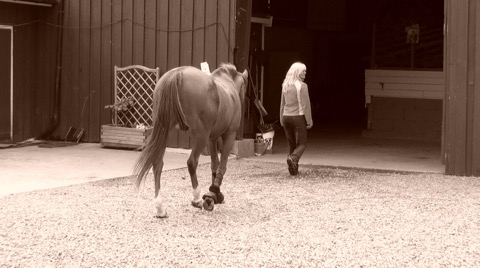
Forsmanship training programs in 2015
-- Foundation Course in Nittedal in Norway in June
- Foundation Course in Norra Bohuslän in Sweden in June-July
- Foundation Course in Eggedal in Buskerud, Norway in July
- Foundation Course in Hallabro near Ronneby in Southern Sweden in August.
Share this page -
Share this page -

a class="social-twitter social-import" href="http://twitter.com/#!/forsmanship">